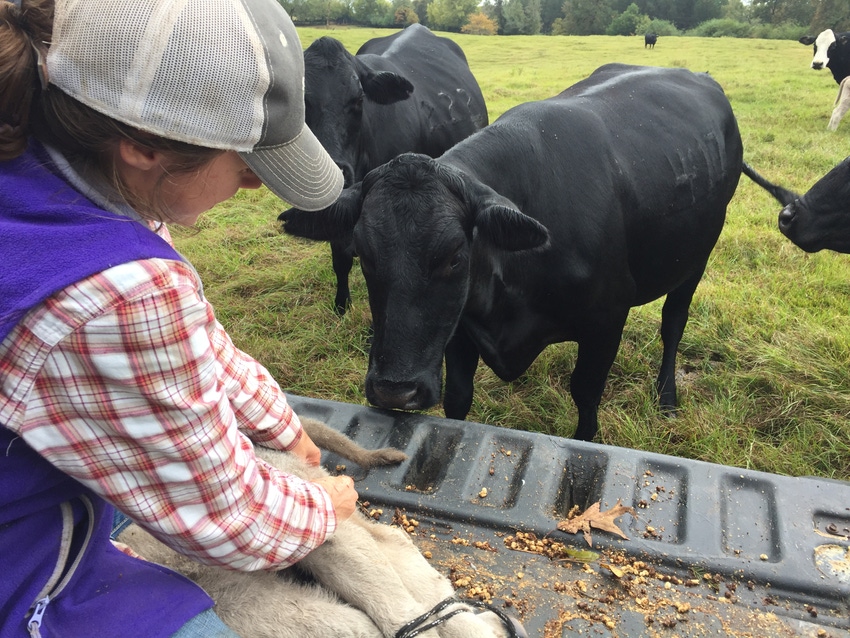November 27, 2018

I saw the weathered unit lying on the flatbed trailer in the front yard. I thought my sister had just forgotten to load it in the ATV. Her “tagging and castration” backpack had been on its last leg for most of the season--the zipper was shot and its contents were not as secure as they needed to be considering the purpose of the pack.
Tagging and castration are risky business regardless of your herd’s disposition. Organization of tools helps. For my sister, these management activities are intended to occur simultaneously and usually within the first week of a calf’s life. Having all of your gear in one portable place makes your life easier.
With Daddy, the pocket knife was always in his deepest Wrangler jean pocket, the cloudy disinfectant was buried behind the single cab truck seat, and the LA-200 was rolling around on the dirty truck floor next to yesterday’s news. Oh, and syringes had to be excavated from the overheated dash board (he hated being cold). Forget the tagging gear, he obviously knew whose calf was whose and would much prefer to torture us if we didn’t. Thankfully, my sister thinks that such brainpower could be better spent toward more productive endeavors. She knows that change is good, and so are ear tags.
What should be a swift process requires proper planning. First, you must catch the calf before it can run faster than you. It’s best if you can do so in a group of other cows. Single calf catches on foot are almost impossible and should only be recommended if you are trying to teach someone humility. Once you do get a hold of the calf’s back leg, you must commit to holding on no matter how far he or she drags you through the manure. Gloves that “slipped off” are no excuse. Also on that list is getting kicked in the face. Trust me, no one ever died from getting kicked in the face by a two-day old calf, no matter how razor sharp their little hooves are. We don’t have time to be sad because you’re bleeding.
You can, however, optimize your chances of personal safety and manage the real risk--the concerned mama cow who is not thrilled that you are holding her distressed calf. A barrier between the calf and the increasingly disturbed mother is highly recommended. A brave family member will work in a pinch. Just remember that you only have a few minutes in which being rapped on the head with a grain scoop will actually deter a determined mama cow. A truck or ATV bed is best—and the higher the better. Though these are not 100 percent--we have had multiple occasions of mothers loading up in the truck bed (and truck cab) when their babies are involved. It’s a dice roll.
Once you have secured a reasonably safe working environment, the next task is to gently lay the calf down and tie off one of the front legs to the two back legs. Perfecting your tie wrap game is key. The correct diameter nylon rope need not be extra-long, or you’ll spend too much time wrapping. Just remember that whatever wrap you tie must be untied just as rapidly when you are done—slip knots only, please.
While everyone has their own opinion about what castration method is best, sis has her way which seems to minimize blood loss and risk of infection. First, she administers a shot of antibiotic. Next she gently clamps her baby vise grips to the tip off the scrotum and then uses a pocket knife to make a clean cut perpendicular to the tip. The hardest part is literally removing the two testes. Those suckers are lodged securely by design, and it takes patience to locate and remove them, especially if one has migrated upward. Once those and all connecting tissues have been removed, a healthy dose of disinfectant is applied to the removal site.
You’d think that castration would be the most painful part for the calf. Not so according to the “holler factor.” Tagging seems to elicit the most blood curdling call a calf can muster. If the mama hasn’t rolled you during the castration process, the ear tag holler might just give her a reason. That’s when you need to have practiced using that tagging gun long before you go on duty. No calf needs a split ear because you choked during the process. And for goodness sake, please make sure it’s the right tag number.
Once that’s complete, you’re ready to untie and release him back to mama. You can wipe off your manure-soaked Wranglers later. Just make sure you have your tools secure in the calf pack as you bolt to the driver’s seat and leave the confused pair in peace.
As it turns out, my sister’s old calf pack lying on the flatbed was being put into retirement. She had finally bought herself a new one, one with a working zipper.
You May Also Like




